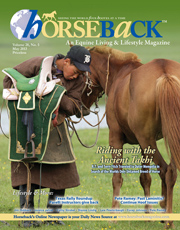by Tim Sullivan, Louisville Courier Journal
This is no time for neutrality.
 With horse racing under unprecedented pressure to put its barns in order, the National Thoroughbred Racing Association finally weighed in Wednesday in support of a bill designed to prevent the return of a domestic horse slaughter industry and to prohibit the export of horses to international slaughterhouses.
With horse racing under unprecedented pressure to put its barns in order, the National Thoroughbred Racing Association finally weighed in Wednesday in support of a bill designed to prevent the return of a domestic horse slaughter industry and to prohibit the export of horses to international slaughterhouses.
For more than a decade, the NTRA had been officially uncommitted on similar legislation, bemoaning underfunded solutions and unintended consequences. But with heat rises on racing from politicians, prosecutors and animal welfare activists, executives have recognized the need to stop quibbling and start speaking unequivocally.
“Clearly the public is very aware; they’re focused on our industry right now, and that’s a factor,” NTRA President Alex Waldrop said Friday. “The time was right to change our position. … Times have changed for us.”
Background: With racetrack deaths, horse racing has another fear: slaughterhouses
In a letter to Congress, Waldrop distanced the NTRA from the Prevention of Equine Cruelty Act of 2008 because of concerns about the industry’s physical capacity to care for unwanted horses and the lack of a funding mechanism to provide that care.
There remains a significant gap between the number of retired racehorses that can be re-purposed and those with no appealing alternatives, but that gap has been narrowing. The U.S. thoroughbred population has been in steep decline for decades, a function of the shrinking size of the annual foal crop.
According to the Jockey Club, more than 150,000 thoroughbreds were active in racing or breeding as recently as 1991. Last year, there were just 80,974: 49,390 racing starters; 30,273 mares bred and 1,311 stallions.
Simultaneously, the European Union’s ban on the importation of horse meat processed in Mexico has diminished demand.
Waldrop estimates that between 7,500 and 10,000 American thoroughbreds are still slaughtered annually, but more than 4,000 per year can now be “re-homed.” Though it’s unclear how the industry would absorb thousands of additional horses should the Safeguard American Food Exports Act become law, it’s plain that solving this problem has attained high priority.
When racing executives met last August in Saratoga Springs, New York, for a 66th annual conference on “Matters Pertaining to Racing,” animal welfare issues were prominent in their discussions. Jockey Club President James Gagliano cited polling by the McKinsey consulting firm that found 50% of casual fans said they would stop betting if they knew horses were mistreated. Within racing’s broader fan base, the No. 1 concern revealed in McKinsey’s research was the treatment of horses in retirement.
Those matters have gained sharper focus with the recent spate of equine fatalities at Santa Anita, with increased scrutiny of industry practices nationwide and with HBO’s airing of graphic slaughterhouse video on its “Real Sports” news magazine show last month.
Wednesday’s announcement by the NTRA coincided with the introduction of the Horse Racing Integrity Act of 2019 on the floor of the U.S. Senate, a bill that would establish a national anti-doping authority and supplant the sport’s inconsistent oversight of 38 racing districts.
Also Wednesday, racing-centric publisher Ray Paulick declared the sport to be at a crossroads.
“One road leads toward national reforms for thoroughbred racing,” Paulick wrote. “The other toward likely extinction.”
Though the risks of extinction might seem remote here in horse country, numerous racing interests recognize the perception of animal abuse as an existential threat to their sport. The threat is taken so seriously in California that officials have included input from animal welfare groups philosophically opposed to horse racing in drafting new policies.
Such concessions reflect racing’s new reality and the belief that the sport’s survival may depend to some extent on accommodating its enemies. Reporting on a conference call earlier this month, Paulick quoted Thoroughbred Owners of California President Greg Avioli to that effect.
“Animal welfare, animal rights organizations have a much larger membership base in California than does the horse racing industry broadly defined,” Avioli said. “So our strategy is to work with their leaders. And their leaders, whether it is the Humane Society or PETA, don’t always say things that are very nice about us, and they definitely don’t always agree with what we do. But we have engaged them at every level, and we are going to continue to do that. Our resources are not the same as their resources.”
Accordingly, this is no time for obstinance.
In agreeing to the gradual elimination of race-day Lasix from stakes races in April, a coalition of leading tracks made a timely show of unity in a notoriously fragmented business. Since then, Churchill Downs and other prominent operators have announced a series of initiatives designed to enhance the welfare of horses and restore the confidence of customers.
“I think the industry is in perpetual reform mode,” Waldrop said. “Unfortunately, we don’t move fast enough. … But we cannot take for granted that we’re going to be able to (continue to) do what we love.”
The notion that horses become expendable as their expenses exceed their income is an idea whose time may have elapsed.
“Years ago, the model was to retire horses on big farms, and they would become lawn ornaments,” Waldrop said. “We warehoused horses, did not euthanize, and we ran out of space.”
Stopping the slaughter of thoroughbreds could create another space crunch and an ongoing financial burden on the racing business. That said, the failure to respond to a crisis is a good way to go out of business.
Categories: Horse News, Horse Slaughter, Uncategorized








“But we cannot take for granted that we’re going to be able to (continue to) do what we love.”per NTRA President Alex Waldrop ! Doing “what they love” is killing thoroughbreds. Quite honestly – fixing this industry has to start back at the breeders – start breeding horses for strong bones & endurance – stop breeding back to the same line every time AND STOP TRAINING & RACING BABIES!!!!!
LikeLiked by 1 person
They and other breeds have turned a blind eye long enough! This industry has tried to police itself without success. It is disgusting that it has taken this long and the deaths of so many young horses to get to this point. I am glad to see they have come on board with their support. However, as I see it they are NOT the only culbrits but the most publized! The horse industry as a whole needs that come to Jesus talk! Quarterhorses are still sent to slaughter in huge numbers because they are trained and broke too early or didn’t come out as expected. Other breeds such as the Arabian Horse Association at the hand of Lance Walters and the Board of Directors angered many members when they voted to support slaughter. Many members felt they didn’t have that right without members support. They also have had their share of inhumane practices. Though many issues have been addressed thru the Equine Stress Committee. Other breeds have their issues too. But probably not as prevalent. The fact remains the Horse Industry needs an overhaul! I believe the cattlemen had a hand in pushing the slaughter issue. In recent years documentation have proven the meat to be toxic and poisonous for human consumption not only the horrific and inhumane treatment of our horses and equines in the whole disgusting process! Who in their right mind would eat this meat or feed it to their family? The time has come and the writing is on the wall!
Horses have been loved throughout the centuries. They served mankind at home and in wars, giving their lives for us! In recent years the component of handicapped riding and helping people with mental disorders has come to light. For those of us with a strong love of horses we knew that all the time! It’s time to take a serious look at all of this! And all the horses and especially Throughbreds imported to foreign countries for racing or breeding who are now being sent to foreign slaughterhouses, notably the South Koreans and the Japanese. Are you people so hard up for money that you sell one of iur country’s treasures out! It’s disgusting! When are breeders going to realize that they just don’t give a damn! They are seen as a commodity! The time has come for us as Americans horse owners and non horse owners to stick up and SUPPORT the horses and other equines we know and love! If your child goes to camp ask the management where that horse will be going after camp is over! If they can’t give you a straight answer don’t send your child there! Let us be their voices for those who teach us to ride and those who bring stability to our lives! Reform the system from top to bottom. And start by passing the Safe Act, Soring bill and the new bill regarding racing! I will guarantee if the Safe Act is passed the kinks will work themselves out but it will take work on everyone’s part!
LikeLiked by 1 person
While researching for an email or contact to a nationwide Oversight Committee, of which there appears not be one,(only by state to state), I was appalled by these facts that came up : there are more than 20,000 foals born ANNUALLY in the US Thoroughbred industry alone, and HALF of these are sent to slaughter.
The average life of a race horse is only three years in competing, and many tracks discard them directly to the kill-buyers after their usefulness has expired.
Only 1% win in the money and the real money is made not by racing, but by the BREEDERS. These horses are just a commodity to them.
Although there are a surprising number of TB rescues and rehabs like Lynn Reardon of ‘ Lonestar Outreach to Place Ex-Racers’ and ‘After the Races’, that successfully find homes and retraining for hunter/jumpers, trail, and show disciplines as well (even dressage), these are still the exceptions in the downward spiral to the slaughter pipeline.
What will it take to get these indiscriminate breeders to stop this insane production for the slaughter industry?
I am wondering the same for the passage of the SAFE ACT this year… WHAT will it finally take to get this all-important bill passed into law???
LikeLiked by 1 person
Gail – you hit a lot of areas involved in the horse industry. Every single discipline (so-called) in the equine industry has the same downside – slaughter! Each discipline involves an area of cruelty & abuse – Western “pleasure” – the peanut roller, shuffle, dressage – the exaggerated headset, and on and on. What happens to camp horses is brutal. If, per chance, they are treated as they should be at these camps & cared for – too many times, the end of summer means they get sent to an auction. And we sure know exactly what that means. I have to say – its not only horses. The idea that we humans are so empathetic & compassionate sometimes becomes a really big stretch!
LikeLike
Perhaps the BIGGEST dirty little secret in the Thoroughbred RACE BREEDING industry is the plight of the offspring of the ‘nurse mares’. These babies are the “by-product” of the surrogate mothers who are brought in to nurse the pedigreed TB foals who are taken from their own mothers so that these valuable TB mares can be shipped back to a stud farm to be rebred, sometimes annually.
The newborn un-pedigreed foals are a few days old when taken, and usually destroyed on site or discarded for… slaughter. There are thousands of these babies produced each year, much like the dairy cow industry. I, for one, had no idea of this, and it just reinforces the horrible lack of ethics in the TB breeders industry!
There are some wonderful people working with rescues in this atrocity though, and the dedication of one woman who has devoted her life to saving as many of these sweet babies as she possibly can is awe-inspiring… Victoria Goss of Last Chance Corral in Athens, Ohio. Check out her incredible rescue service on YouTube and Facebook everyone. She has restored a little bit of faith in the human race for my sore heart.
LikeLiked by 1 person
I remember reading about these mares & their foals a couple years ago & the Last Chance Corral & what a wonderful thing they do for these babies. This is no different than the Premarin mares & foals – same outcome for far too many of the babies – treated as a by-product of this industry. What is done to so many domestic animals so that the profit can keep on coming?
LikeLike
Very hypocritical the Humane Society has so much concern over humane care and lives of racehorses but so little for our wild horses and burros. How does rounding up wild mares and tearing out their ovaries in the name of pointless “research” square with their supposed ethics?
Their mission statement includes opposition to “animal testing” along with opposition to cruelty and supporting laws protecting animals. Wild horses are facing extinction now in large part to HSUS collaboration with those who want them sterilized and largely existing in non-reproducing herds (contrary to law), yet this matter isn’t even listed as one of their “big fights” on their website.
https://www.humanesociety.org/our-mission?credit=ad_gg_slink_general_2018&msclkid=6323eb969a3713c9f532b69f80f849cd&utm_source=bing&utm_medium=cpc&utm_campaign=Humane%20Society%20-%20Branded&utm_term=hsus&utm_content=HSUS
LikeLike
Here is the link to see the Humane Society 990 tax form (2016).
You may wish to note that they own assets of more than $51 million dollars in central america and the caribbean. Why?
CENTRAL AMERICA AND THE CARIBBEAN INVESTMENTS $51,469,167
Click to access 2016-hsus-irs-form-990.pdf
LikeLike
Icyspots… a sad truth is that for the majority of people in our country Wild Horses and Burros are unknown and invisible, even with the incredible amount of advocates trying to make a difference on their behalf. Most think of them as being something of the past like the 19th century, and then only a few here and there in Arizona or Nevada, like some old movie.
They have no clue.
The “Humane Society” is miserably failing their supposed “mission” in regard to our equines, and I really question their true ethics at this point.
LikeLike